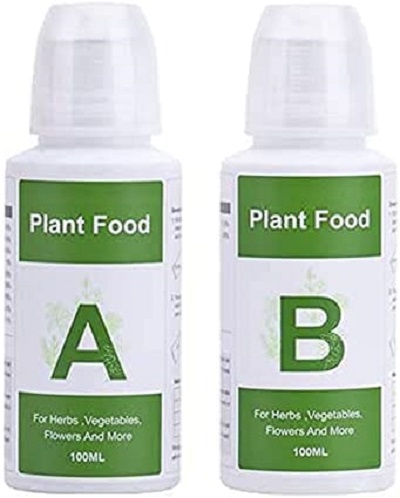
Before making a purchase of the nutrient solution formulation, obtain the elemental content concentration for all the contained elements in the prepared solution as well as the dosage recommendations. In addition, ask whether there the dosage modifications based on the hydroponic growing method [flood-and-drain, nutrient film technique (NFT), and drip irrigation], plant species grown, and/or stage of plant growth.
When making the selection of a nutrient solution formulation, be sure that you are given these 3 things:
- The elemental concentration content of the prepared “to be used” nutrient solution
- Recommended frequency of application
- Volume of nutrient solution to be applied with each application
These 3 factors are interrelated as elemental concentration, frequency of application and volume applied will affect plant growth and the nutrient element sufficiency status of the growing plant. A useful rule of thumb is that with increasing frequency of application and volume applied at each application, the lower the elemental concentration in the formulation should be. In fact, a diluted nutrient element formulation (low elemental concentration), the more “friendly” the solution will be in terms of establishing and maintaining plant nutrient element sufficiency.
Growers need to be aware that with each nutrient solution application, there is an accumulation of elements, both soluble and insoluble, an accumulation that becomes a major source of elements, not that being applied with each application of the nutrient solution. Therefore, the grower’s ability to control the nutrient element status of the plant will be determined by the balance between that being supplied with each irrigation and that existing in the rooting media (for the NFT method, within the root mass). Although there may exist a wide range in elemental concentration among nutrient solution formulations, plants seem to be able to adjust and grow normally.
For the commercial grower, however, control of the nutrient element rooting environment is essential for maximum plant performance, requiring both skill and experience on the part of the grower. A good guide for evaluating the elemental content and concentration in a purchased nutrient element formulation is to make a comparison with that found in a Hoagland/Arnon nutrient solution formulation (Jones, 2011, see pages 44-45).
Within the nutrient solution formulation itself, the ionic form of an element, its concentration, and ratio among the companion elements are important parameters. For example, the form for nitrogen (N), whether as the nitrate anion (NO3-) or the ammonium cation (NH4+) will affect plant N utilization, and in term, affect plant growth. A mix of both forms, about 75% nitrate and 25% ammonium is about the best ratio mix. There is no place for chelates in a nutrient solution formulation as they offer no benefit, and in addition, the chelate, EDTA, has been found to be toxic to some plants. Many formulations are higher in phosphorus (P) than needed, resulting in the potential for either iron (Fe) and/or zinc (Zn) deficiency as well as being a factor contributing to the accumulation of a calcium phosphate precipitate in the rooting media. Experience has shown that the P concentration in a prepared nutrient solution should be between 10 to 30 ppm.
The ratio among the three major cations, potassium (K), calcium (Ca) and magnesium (Mg) is important to avoid the potential for creating primarily a Mg deficiency, a deficiency that will not normally result in visual leaf symptoms but will be manifested as slow and/or reduced plant growth (usually not easily seen). There is no advantage in having elements other than the essential elements in a nutrient solution formulation; the only exception might be for the element silicon (Si) whose inclusion being determined by the plant species being grown and the characteristics of the rooting medium. Inclusion of other non-essential elements in a nutrient solution formulation is not justified.
Many of the so-called “specialized” nutrient solution formulations are questionable as to their need – formulations that are specified for the supposed ability to influence fruit set and quality, flower production and enhanced plant growth during vegetative, and/or flowering and fruiting plant stages. What elements in these formulations are being altered and extent of alteration from the normal formulation content and concentration levels need to be identified.
Changing the elemental concentration by altering the dilution ratio during the plant growth cycle is a questionable practice since there occurs an accumulation of elements within the rooting media (even within the root mass for the NFT growing method) that will contribute to the plant’s nutrient element needs. Any dilution ratio change should be such as to provide as constant a level of elemental concentration as possible over the entire plant’s growing period. Such a constant elemental/rooting environment will provide the best conditions for sustaining both plant growth and nutrient element sufficiency.
Dr. J. Benton Jones, Jr. has a PhD in Agronomy and is the author of several books. Dr. Jones has written extensively on hydroponic growing and outdoor vegetable gardening employing sub-irrigation hydroponic growing systems.
Reference:
Jones, Jr., J. Benton. 2011. Hydroponic Handbook: How hydroponic growing systems work. GroSystems, Inc., Anderson, SC.
Related Articles & Free Email Newsletter Sign Up
Before Buying a Chemical Fertilizer – READ THE LABEL!
pH? Widely Used, Little Understood
Phosphorus is Needed by Plants But Too Much Hurts More Than it Helps




Comment here